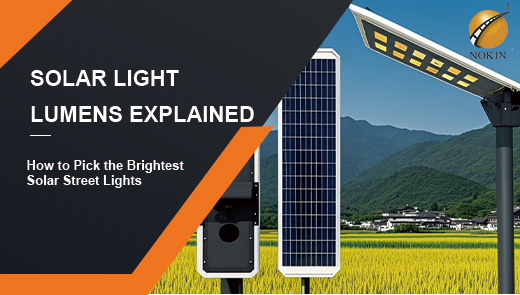Top 10 FAQs About Solar Street Lights
Feb 12, 2025
As a green and energy-saving lighting device, solar street lights are becoming increasingly popular due to their environmental performance, cost savings, and efficient and stable lighting efficiency. Whether you are considering installing solar LED street lights in residential areas, commercial projects, or public places, you may have many questions before investing. Next, Nokin will sort out ten common questions about solar powered street lights for you, hoping to help you make the right decision.
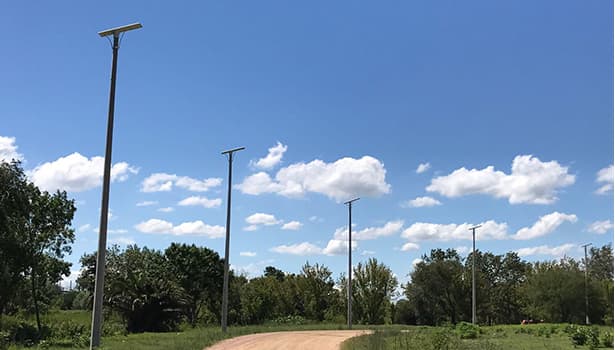
Solar panels: capture sunlight and convert it into electricity.
Batteries: store energy for nighttime use.
LED lights: provide bright and efficient lighting.
Charge controllers: regulate the current to prevent overcharging or over-discharging.
Light poles and mounting structures: support solar panels and lamps.
Solar panels: 20-25 years
LED lights: 50,000+ hours (about 10-15 years)
Lithium batteries: 5-8 years (depending on quality)
Charge controller: 5-10 years

Small-scale applications: 2000-5000 lumens
Residential streets and parks: 6000-10,000 lumens
Highways and commercial areas: 12,000+ lumens
A larger battery capacity can store excess energy for later use.
High-efficiency solar panels can effectively capture even low sunlight levels and improve charging efficiency.
The MPPT charge controller can optimize power conversion in low light conditions.
For areas with longer rainy seasons, you can give priority to models with at least 3-5 days of backup power.
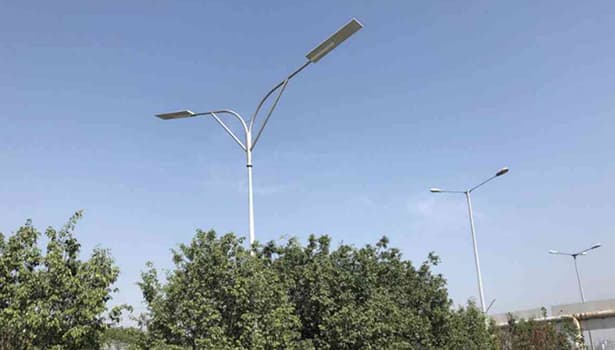
No wiring is required. Customers do not need to dig trenches for solar street lights, which can save electrician fees and wire costs.
Solar powered outdoor street lights make it easy to achieve intelligent control and save energy.
The luminous efficiency of solar led street lights is about 10% higher than that of electronic LED lights, so solar powered street lights can reduce the power of LEDs when achieving the same brightness.
Clean the solar panels every 3-6 months to remove dust and debris.
Check the battery health every 1-2 years.
Make sure the LED lights and controller are functioning properly.
With proper care, the system can last 10-20 years without major issues.
IP65 to IP68 waterproof ratings for protection against rain and dust.
Select corrosion-resistant materials suitable for wet and coastal areas.
Use wind-resistant poles that can withstand strong winds.
Solar streetlight manufacturers recommend that you always check the IP rating and material quality before purchasing.
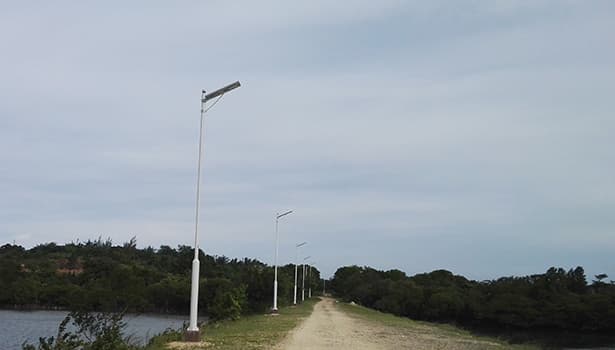
Choose a location with maximum sunlight exposure.
Mount the pole and install the solar panel.
Connect the battery and LED light module.
Adjust the tilt angle for optimal sunlight absorption.
Reduced electricity bills: 100% solar-powered, no need to pay high electricity bills.
Environmental benefits: No carbon emissions, an environmentally friendly lighting solution.
Low maintenance: Durable components with minimal maintenance costs.
Easy installation: No trenching or wiring is required.
Reliable lighting: Works even during power outages.
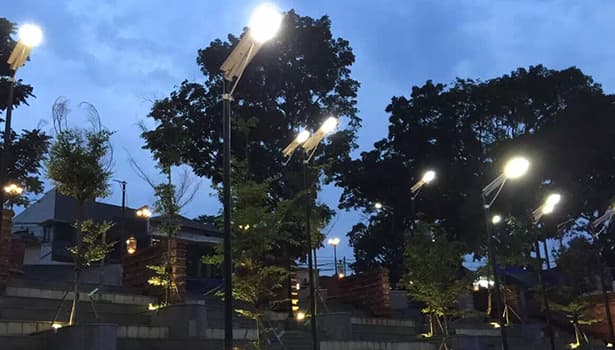
Solar street lights are a smart, cost-effective, and sustainable lighting solution. Whether you are looking for residential, commercial, or municipal lighting, they can provide long-term benefits and reduce dependence on traditional power sources.
Still have questions about solar powered led street lights? Contact Nokin today for expert advice and a free consultation!

1. How do solar street lights work?
Solar powered LED street lights operate by converting sunlight into electricity using photovoltaic (PV) panels. During the day, these panels absorb solar energy and store it in rechargeable batteries. At night, the stored energy powers LED lights, providing lighting without relying on the power grid. Some models are equipped with motion sensors to improve energy efficiency.2. What are the main components of solar lights for streets?
Solar street lights generally consist of the following parts:Solar panels: capture sunlight and convert it into electricity.
Batteries: store energy for nighttime use.
LED lights: provide bright and efficient lighting.
Charge controllers: regulate the current to prevent overcharging or over-discharging.
Light poles and mounting structures: support solar panels and lamps.
3. What is the service life of solar street lights?
The service life of solar led street lights depends on their components. At the same time, regular and effective maintenance can extend the service life of the streetlight system:Solar panels: 20-25 years
LED lights: 50,000+ hours (about 10-15 years)
Lithium batteries: 5-8 years (depending on quality)
Charge controller: 5-10 years

4. Are solar powered street lights bright enough?
Yes, modern solar street lights use high-efficiency LED technology, and the brightness level is comparable to traditional street lights. Brightness is measured in lumens, and you can choose the appropriate brightness according to the specific application scenarios:Small-scale applications: 2000-5000 lumens
Residential streets and parks: 6000-10,000 lumens
Highways and commercial areas: 12,000+ lumens
5. Can solar powered outdoor street lights be used on cloudy or rainy days?
Yes, solar street lights can still work on cloudy or rainy days, but their efficiency may be reduced. If you want to extend the working time of solar led street lights in rainy weather, you can improve the configuration of street lights and choose:A larger battery capacity can store excess energy for later use.
High-efficiency solar panels can effectively capture even low sunlight levels and improve charging efficiency.
The MPPT charge controller can optimize power conversion in low light conditions.
For areas with longer rainy seasons, you can give priority to models with at least 3-5 days of backup power.

6. How do solar lights save money?
100% solar energy, no electricity bills to pay. Maintenance costs are much cheaper than traditional street lights.No wiring is required. Customers do not need to dig trenches for solar street lights, which can save electrician fees and wire costs.
Solar powered outdoor street lights make it easy to achieve intelligent control and save energy.
The luminous efficiency of solar led street lights is about 10% higher than that of electronic LED lights, so solar powered street lights can reduce the power of LEDs when achieving the same brightness.
7. Do solar street lights require maintenance?
Solar powered led street lights require minimal maintenance. Recommended maintenance includes:Clean the solar panels every 3-6 months to remove dust and debris.
Check the battery health every 1-2 years.
Make sure the LED lights and controller are functioning properly.
With proper care, the system can last 10-20 years without major issues.
8. Are solar street lights waterproof and weatherproof?
Yes, most solar led street lights are designed to withstand harsh weather conditions. Key features include:IP65 to IP68 waterproof ratings for protection against rain and dust.
Select corrosion-resistant materials suitable for wet and coastal areas.
Use wind-resistant poles that can withstand strong winds.
Solar streetlight manufacturers recommend that you always check the IP rating and material quality before purchasing.

9. How difficult is it to install solar street lights?
Installing solar powered outdoor street lights is easier than traditional street lights because there is no need for complex trenching and wiring projects, and most models are designed with a plug-and-play design for quick installation. The basic steps include:Choose a location with maximum sunlight exposure.
Mount the pole and install the solar panel.
Connect the battery and LED light module.
Adjust the tilt angle for optimal sunlight absorption.
10. What are the benefits of using solar street lights?
Solar powered street lights have many advantages that make them ideal for smart cities, highways, parks, and remote areas. Including:Reduced electricity bills: 100% solar-powered, no need to pay high electricity bills.
Environmental benefits: No carbon emissions, an environmentally friendly lighting solution.
Low maintenance: Durable components with minimal maintenance costs.
Easy installation: No trenching or wiring is required.
Reliable lighting: Works even during power outages.

Solar street lights are a smart, cost-effective, and sustainable lighting solution. Whether you are looking for residential, commercial, or municipal lighting, they can provide long-term benefits and reduce dependence on traditional power sources.
Still have questions about solar powered led street lights? Contact Nokin today for expert advice and a free consultation!



